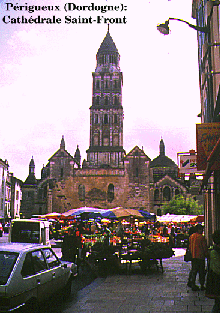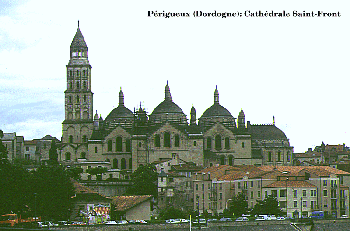Périgueux: A City with a Secret
General Daumesnil was a native of Périgueux. He followed Napoleon's star to Italy, to Egypt, to Austria, and left a leg on the battlefield of Wagram. Pensioned off as Governor of the Château de Vincennes he was summoned to surrender by the victorious Allies in 1814. I'll give you Vincennes, he yelled across the moat, when you give me back my leg. The performance was repeated in 1815 after Waterloo; it was five months before Daumesnil was the last of Napoleon's generals to surrender. King Louis XVIII, recognising a character when he met one, left Daumesnil in charge of Vincennes; and when the Bourbon monarchy finally collapsed in 1830, Daumesnil was still there to refuse the mob access to the castle and the Royal Ministers detained in it.
This ability infallibly to choose the losing side, yet always to come up smiling, is the essence of the Périgourdin attitude to life. The Petrocorii (it means Four Tribes in the language of ancient Gaul) were for Vercingetorix, and their city of Vesuna was among his strongholds. When Vercingetorix was beaten by Caesar, Vesuna knew three hundred years of prosperity as an important town of Roman Aquitania. But in the end even Rome turned out to be the losing side. By the third Century the people of Vesuna were tearing down their splendid amphitheatre to build walls against the invading Barbarians.
It was no use, of course. Nothing was any use against the Alamans. Or, in the next few centuries, against the Goths, the Visigoths, the Franks, the Saracens, the Normans and finally, worst of all, the English. Like football supporters, they were mostly just passing through, but they left their mark as they passed. And after each passage the men of Vesuna would dust themselves off, console their ravished womenfolk and pull down yet more Roman ruins to build newer, thicker and equally useless walls. The thing to be in the Dark Ages was a builder. There was always work, but nobody expected anything to be permanent. Within a few years it would all be burnt again, and the population hiding in the woods.

The traditional foods of Périgord are woodland foods, the animals those easily hidden. Pigs, ducks, geese; game and river fish; mushrooms, including cèpes, chanterelles, morilles as well as the incomparable truffle; walnuts and the fruits of the forest. Even foie gras may have been the result of keeping geese indoors out of reach of marauders, and ramming down their throats any food, however unpalatable, that came to hand.
In the Hundred Years War the English held the land North of the Dordogne, the French that to the South. Périgueux, well inside the English domain, held obstinately to its allegiance to France. During the Wars of Religion, while most of Aquitaine was full of Protestants under catholic rule, the people of Périgueux stuck doggedly to their Catholic faith despite the Protestantism of their rulers. And in the Fronde of the seventeenth Century the town, unswerving in its loyalty to the crown, was occupied and governed by the arch-rebel Condé.
 I came into
Périgueux for the first time from the North, from
Angoulême and Brantôme and the rural fastnesses of the
Dronne valley. From this side the town reveals itself slowly; the
charming curve of the river Isle in which it rests is hidden behind
the hills. The first surprise is the Cathedral: Oo look, Daddy,
somebody's sat on the Sacré-Coeur! and the second is the
liberal provision of car-parks. We were lucky there, of course; it wasn't market day. On Wednesdays and Saturdays considerable local
knowledge is required, or a capacity for getting up before dawn. We
parked, however, in Place Francheville and approached the Cathedral
along Rue Taillefer.
I came into
Périgueux for the first time from the North, from
Angoulême and Brantôme and the rural fastnesses of the
Dronne valley. From this side the town reveals itself slowly; the
charming curve of the river Isle in which it rests is hidden behind
the hills. The first surprise is the Cathedral: Oo look, Daddy,
somebody's sat on the Sacré-Coeur! and the second is the
liberal provision of car-parks. We were lucky there, of course; it wasn't market day. On Wednesdays and Saturdays considerable local
knowledge is required, or a capacity for getting up before dawn. We
parked, however, in Place Francheville and approached the Cathedral
along Rue Taillefer.
Rue Taillefer contains a trap. You set off down it with the full intention of getting to the Cathedral, but at No. 21 you are waylaid, stopped dead in your tracks by Pierre Champion, whose shop is the world capital of foie gras with truffles. Now you may object violently to the force-feeding of geese (though the geese, waddling bravely to move a body which can, by the end, be composed of more than fifty percent liver, are widely reported to queue up for their meals and make no objection to the process); you may think truffles overpriced for a bit of fungus dug up by a pig; but I challenge you to walk down Rue Taillefer and not stop. At least to gaze, and maybe to drool a little.
Eventually, however, the Cathedral is reached. And yes, it looks as if somebody has sat on the Sacré-Coeur, It is all domes and cupolas, massive walls and round-headed windows. You enter under the bell-tower, through what seems to be the world's largest porch but is in fact the previous Cathedral, built in 1047 and ravaged by fire in 1120. Through it you come to Saint-Front itself, built in 1173 and ravaged by Protestants in 1575 and by restorers from 1852 to 1901. And it is with a sense of inevitability that you learn that the principal restorer was Abadie, who went on from here to design – you guessed – the Sacré-Coeur de Montmartre.
When Abadie
restored a place, it knew it was being restored. He respected the
general Byzantine style of Saint-Front, but changed its plan, its
height, its colour (the domes are stone-covered where once there were
red tiles) and its silhouette; all those little pepperpot turrets,
and I counted twenty of them, were his idea. Much horror was
expressed at the time, but who knows now whether the old was more or
less impressive? I found it overwhelming; the sense of size and sheer
weight in those vast stone domes, the pillars so thick that they have
passages cut through them six feet wide, and the feeling, despite
restoration, that these stones had seen a thousand years and were
ready for thousands more.
Outside the
Cathedral the Cloister garden is cool in the Summer heat, and its
Gothic forms a neat bridge between the twelfth and fifteenth
centuries; for a right turn brings you into the Middle Ages. A whole
town of cobbled streets, studded doors, corner turrets, mullioned
windows; street after pedestrianised street of Renaissance stairways,
hidden courtyards, ornamental carvings and secret gardens; there is a
tower, the Tour Mataguerre, part of the ancient ramparts and with a
fine view over the red rooftops; and all the time a nagging thought;
this is beautiful, beautiful, but things are missing. Where is the
Castle? Where the palaces? Where was the citadel, the seat of power?
It is when you get to the Office de Tourisme in a comparatively modern area below the Cathedral that you begin to understand. A notice tells you that many of those secret houses can be visited on weekdays on the Circuit médiéval-renaissance; but there is also a Circuit Gallo-Romain. And the smiling lady behind the counter reveals that in the heart of Périgueux there is not one town, but two; one Roman, one Medieval; one aristocratic, one bourgeois; one Classical, One Romantic.
The Classical
town is a few hundred yards to the West. It has its own domed church,
Saint-Étienne-de-la-Cité, which was the Cathedral until
1669 when the armies of the Fronde demolished it – not for the first
time; it has a Castle, the Château Barrière, and the
remains of a Bishop's Palace; there is a tower, Tour de
Vésone, seventy feet high and faced in red cement, which is a
thousand years older than the twelfth-century cathedral; the remains
of Roman houses, villas and shops are here, and the Rue des
Gladiateurs brings you to an elliptical garden which was once the
largest amphitheatre west of Nîmes.
The town of
Vesuna, you see, developed a persecution complex. Pillaged and burned
over and over again from the third century to the tenth, it curled up
as small as it could get, wrapped itself in heavy walls and turned
its back on the world. Even its name it hid. People called it the
City of the Petrocorii, or just La Cité. The Count of
Périgord lived and ruled there; there was room for the Bishop
and the Cathedral. But when the Dark Ages ended and the new dawn
began, Vesuna's light was out. The rising Middle Class established
themselves on the next hill, the Puy Saint-Front, where a small
shrine to the Apostle of Périgord (sent, they say, by Saint
Peter himself to evangelise the region) had become a hermitage, a
place of pilgrimage, an abbey and finally a town. In the eleventh and
twelfth centuries, while the growing prosperity of this place built
the great church of Saint-Front, there were constant arguments and
skirmishes between the two towns, until they were united under the
name of Périgueux in 1251.
When we left the town by the South-Eastern road to Bergerac and Cahors, we crossed the river by the Pont Saint-Georges; and there, looking back, it was all clear; the two hills, the two towns, the domes and towers against the setting sun. If we had come that way, there would never have been any doubt. But I like a town with modesty, which gives up her secrets one by one, not to be grasped and manhandled by every passing stranger; and I shall come back to a place where I know there is more to find.
Hedley Grenfell-Banks